



Bonding Energy
launch Bonding Energy(please enable Java)




|
Bonding Energy is part of
Cross Current Resonance Transducer,
a collaboration between Douglas Repetto
and LoVid (Tali Hinkis and Kyle Lapidus).
Cross Current Resonance Transducer is an open-ended collaboration and research project. We are interested in the processes of interpretation and evaluation that are inherent in human attempts to understand natural phenomena. Inspired by the story of the pulsar's discovery, we develop systems for monitoring, manipulating, and interpreting natural signals such as electromagnetic radiation, tidal patterns, ambient temperature gradients, wind, and barometric pressure modulations. Our interest is not so much in presenting the phenomena themselves, but rather in exploring the often flawed but revealing interpretations of those phenomena that ultimately lead to greater human understanding and scientific progress. Our investigation has expanded from an initial focus, which emphasized using standard environmental sensors, to an interest in building our own environmental monitoring devices. The goals of CCRT are not scientific or pedagogical; rather, we're interested in exploring the potential and the limits of data interpretation as a human activity that is necessarily informed by aesthetic and subjective preferences and choices. We find the process of science, of humans exploring and trying to make sense of the world, endlessly compelling and inspiring. At the same time, science is a cultural activity, one full of personalities, preferences, biases, alliances, and all of the other complications that come with any human activity. We are interested in exploring both the achievements and wonders of science, but also the ongoing, perhaps unresolvable conflict between science's claims of objectivity and the unavoidable subjectivity of its practitioners. Although Bonding Energy is a data visualization, it makes no claims to objectivity or rigor. It is purposely subjective, marginal, made with home-made equipment designed via the interpretation of previous generations of flawed data. If our work in CCRT claimed to be science it would be very bad science; hopefully it is compelling and beautiful as something else. Our current CCRT project, Bonding Energy, is focused on electromagnetic radiation (solar energy). It reflects our growing interest in not only collecting and analyzing environmental data, but also in using the signals we investigate as potential renewable energy sources. Bonding Energy is an electrogeography and data visualization project inspired by ideas associated with micro-credit loans and distributed computing applications such as SETI@home. It presents a model system for distributed microenergy generation in which geographically dispersed devices collaborate to analyze a large scale phenomenon (light levels) using solar panels. In a microenergy system these panels would also harvest energy from the light they measure. Bonding Energy's live graphical representation of luminance readings suggests the utopian possibility that many such small local energy collecting devices could produce a greater effect than the sum of their parts, helping contribute to energy independence. Bonding Energy consists of a set of "Sunsmile" devices that measure solar energy from seven sites around New York State. We have invited a group of geographically distributed media arts institutions in New York State to participate in Bonding Energy by hosting one of the Sunsmile devices that measure and send solar data to a central server. In keeping with our general CCRT working method, the physical form of the devices was determined by our interpretation of a previous generation of solar data manually collected in our studios each day during January 2007. The 31 data points were used to cut acrylic rings for the bodies and to create molds for the cast plastic bases. Each Sunsmile also holds a printed circuit board and has a small solar panel sitting on top. Every ten minutes each Sunsmile device takes a reading from its solar panel and sends the data to the turbulence.org server. When a viewer visits Bonding Energy they are presented with a live visualization of the data collected from the seven devices. Data from each device is represented by a wedge in an animated circle. The colors in the wedges change as the data from the previous seven days is played back; oranges represent low light levels, yellows medium, and blues indicate high ones. Highlighted bands indicate maximum and minimum data values, and a rotating line of text displays the date and time of the data being displayed in the center of the circle at each moment. Shapes overlaid on the animation represent changing data relationships between and within the Sunsmile devices.
Bonding Energy was commissioned by turbulence.org and will be accessible via this website from October 2007 to October 2008. We are happy to share the data collected by the Sunsmile devices; for access information, please contact: ccrt [at] music columbia edu. |
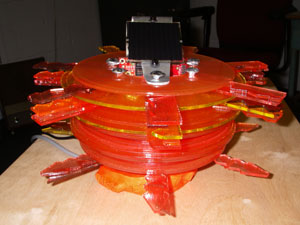 Sunsmile #0 Columbia University Computer Music Center
|
||
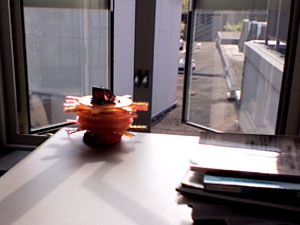 Sunsmile #6 Colgate University Department of Art and Art History |
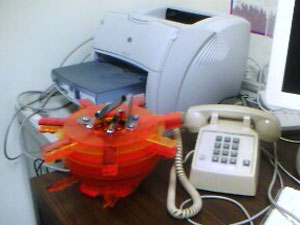 Sunsmile #5 SUNY Buffalo Visual Studies |
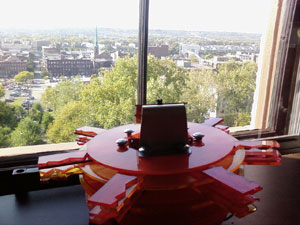 Sunsmile #4 RPI's iEAR studio |
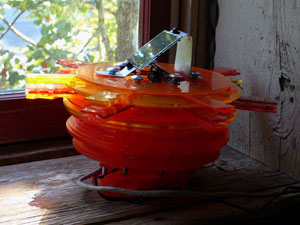 Sunsmile #3 Experimental Television Center |
Bonding Energy was developed at in an AIRtime residency at free103point9 Wave Farm, studios at the Columbia University Computer Music Center, and the Eyebeam Education Studio and R & D Open Lab.
Special CCRT thanks to: Helen Thorington, Jo-Anne Green, Jesse Gilbert, Dana Piazza, Yael Kanarek, Mouna Andraos, Tom Sherman, James Powderly, free103point9, The Computer Music Center, Eyebeam, The Greenwall Foundation, Harvestworks, The Experimental Television Center, NYSCA, our Sunsmile hosts (see below), and of course turbulence.org.
The seven Sunsmile devices are hosted at sites around New York State thanks to the generosity of:
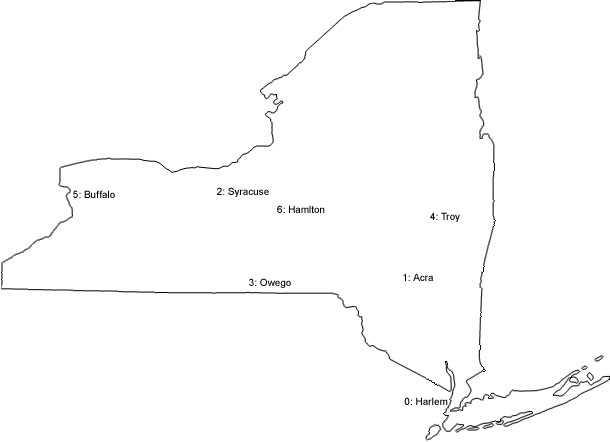
free103point9 is a nonprofit arts organization focused on establishing and cultivating the genre Transmission Arts by promoting artists who explore ideas around transmission as a medium for creative expression.
The Redhouse is a multi-arts center with the mission to present innovative theatre, film, fine art, and music in an intimate setting. Special thanks to Hank Rudolph.
ETC's programs are supported by the Electronic Media and Film Program at the New York State Council on the Arts; Daniel Langlois Foundation for Art, Science, and Technology; the Media Arts Program of the National Endowment for the Arts; mediaThe foundation; the Institute for Electronic Arts at Alfred University; by corporate support from Dave Jones Design and Black Hammer Productions and by the contributions of many individual artists.